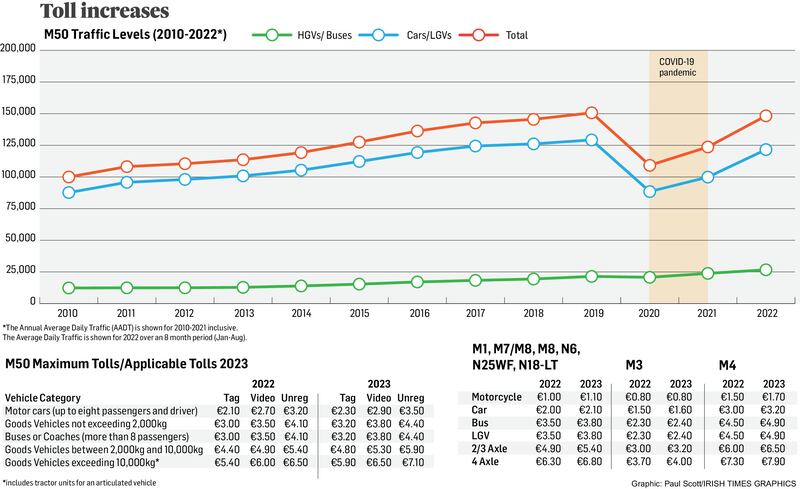Traffic on the State-owned M50 around Dublin has soared by almost 50 per cent over the past decade, bringing in more than €140 million in tolls and penalties last year alone, latest figures show.
The number of vehicles a day on the country’s busiest motorway has swollen from 99,962 in 2010 to 148,245 this year, as the route makes a near-full recovery to business as usual after a dramatic drop-off in use during the pandemic.
Apart from 2019 — the year before the Covid outbreak in Ireland — the M50 has never been busier. In fact, it may be nearing as busy as it can get.

The State roads operator Transport Infrastructure Ireland (TII) predicted in its latest annual report a drop in the growth of traffic volumes over the short to medium term because of ever-increasing congestion.
Other than nine targeted toll hikes — all of 10 cent — affecting particular classes of commercial vehicles, charges have remained largely the same on the M50 since 2013. As traffic volumes bounced back last year, tolls were widely increased.
While cars and taxis using electronic tags to pass the barrier-free toll were not affected, all other drivers of private vehicles saw a 10-cent increase per journey from €2.60 to €2.70 (registered) and from €3.10 to €3.20 (unregistered).
[ Tolls on Irish roads to rise to ‘maximum’ price allowed from JanuaryOpens in new window ]
Buses, coaches, vans and lorry drivers were also lumbered with a 10-cent hike.
The increases coincided with a 13 per cent jump in income from the tolls, up to €140m from €124 million.
On Wednesday, TII confirmed drivers will face more significant toll increases starting on January 1st, 2023.
For the first time in a decade, car drivers using an electronic tag will see their bills go up, from €2.10 per journey to €2.30. Registered drivers picked up on video going through the barrier-free toll will pay €2.90, up from €2.70.
Unregistered car drivers will be charged €3.50 — up from €3.20.
Trucks and lorries
Commercial vehicles, including buses, coaches and hauliers will also bear the brunt of the increases. Tagged goods vehicles (less than 2,000kg) and buses will be charged €3.20, up from €3. Those picked up on video will be billed €3.80 , up from €3.50, while those not registered will pay €4.40, rising from €4.10.
Trucks and lorries can expect to see tolls of between €4.80 and €7.10 per journey.
The rises — linked to inflation of 8.6 per cent between August 2021 and August 2022 — are in most cases higher than 9 per cent. TII said this is calculated by multiplying the previous year’s toll by the rate of inflation — as measured by the Consumer Price Index — against a “base year” rate in 1996.
The figure is then “rounded upwards or downwards, as the case may be, to the nearest 50 cent or such other amount [equal to or less than €1]”.
The TII confirmed that the State has discretion in increasing — or even reducing — tolls. Any increases are capped by the rate of inflation but they are not linked to it.
A spokesman for the State operator said decisions to increase charges are based “on the cost implications of inflation” and that the “money would have to be found somewhere else” if a decision was taken to freeze tolls.
A crude calculation — based on roughly 9 per cent hikes across the board and current traffic levels — suggests the M50 will next year take in a record €152 million.
In its latest annual report, the TII says it has 48 employees earning more than €100,000.




